Yamaha MODX 6 Review – An Exceptional Piece of Hardware
Yamaha’s new MODX synth has the bulk of the features from the Mothership MONTAGE, but is almost £1,000 cheaper! Andy Jones joins the MOD squad… Price £1242 Contact Yamaha | https://europe.yamaha.com/en MODX 6 key features: Motion Control synth with AWM2 and FM-X engines 5.67GB preset sounds; 1GB user memory 128+64-note polyphonic 16-part multitimbral Super Knob […]
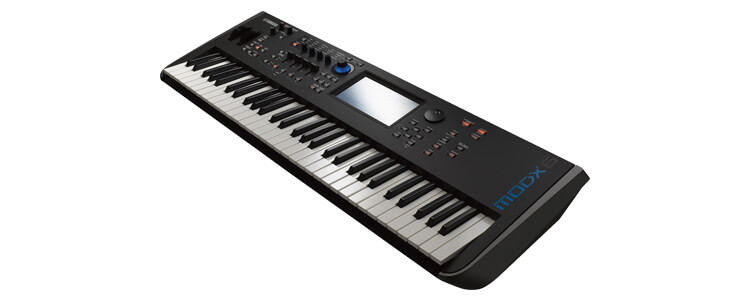
Yamaha’s new MODX synth has the bulk of the features from the Mothership MONTAGE, but is almost £1,000 cheaper! Andy Jones joins the MOD squad…
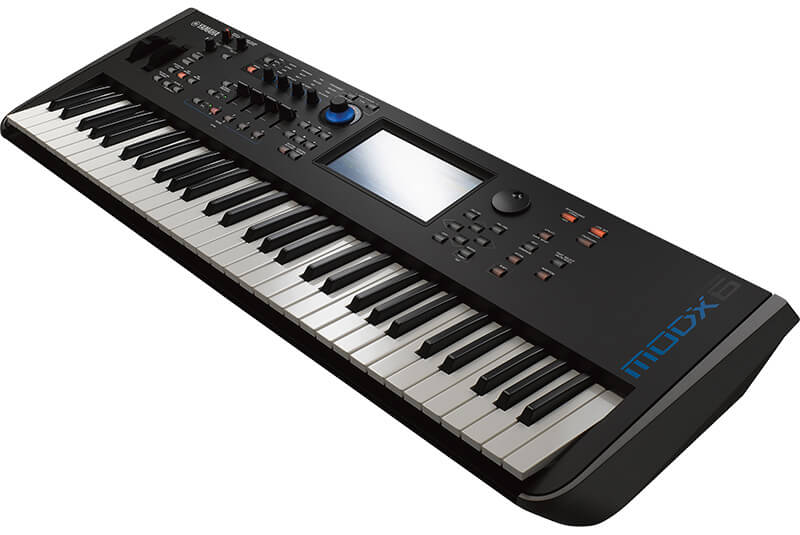

Price £1242
Contact Yamaha | https://europe.yamaha.com/en
MODX 6 key features:
- Motion Control synth with AWM2 and FM-X engines
- 5.67GB preset sounds; 1GB user memory
- 128+64-note polyphonic
- 16-part multitimbral
- Super Knob for multiple parameter changes
- Motion sequencer
- 130,000 event sequencer
- 18 filter types
- Approx. 85+ insert/master fx
- 2 Outputs, 2 Inputs, 2 x MIDI 4 foot controllers, 2 USB, power, headphones
- Weight (kg): 6.6
- Size (WxDxH in mm): 937 x 331 x 134
The Yamaha MONTAGE synth is something of a MONster synth in terms of both what it can do – that’s pretty much everything – and it’s physical size (I reviewed the biggest one and did myself a mischief trying to get it up the stairs). In fact I’d go as far as to say that it is by far the most fully-featured synth I’ve looked at for MusicTech and, with its touch-sensitive screen and Super Knob, it was among the most fun to play as well.
There’s always a ‘but’ though isn’t there? Well that kind of power doesn’t come cheap, and the most expensive of the MONTAGE range – the 88-note weighted keyboard version – will cost you just shy of three grand, with the cheapest somewhere around £2,200.
The MONTAGE was always touted as the ‘umbrella’ keyboard (that is the ‘brand leader’, the ‘mothership’ the ‘whatever other bad corporate lingo I can insert in here’) for an entire new line of Yamaha keyboards. So where does the company go next? Cut down? Yes, slightly. And cheaper? Yes, a lot. Welcome to the new MODX 6…
A quick montage
You’ll need a quick summary of my MONTAGE review before we head forward with the MODX 6, because this synth is a cut down version of that, but hopefully not too cut down.
MONTAGE is one of those old school digital synths that makes every sound imaginable, albeit with about a thousand bells added on. It has two synthesis types: AWM2 and FM-X within a Motion Control Synthesis Engine, which is quite brilliant in concept and execution.
AWM2 is Yamaha’s sample-based engine with around 6GB of high quality sounds that really does cover everything real and imaginary. The MOTIF series was the flag-bearer for digital synths for many years, but MONTAGE blows it away with a sample library eight times the size. The FM-X engine is great too, a more accessible FM synthesiser.
And indeed ‘more accessible’ just about sums up MONTAGE. As part of the Motion Control Synthesis Engine, synth parameters can be accessed and recorded with ease. You can assign several to the Super Knob and adjust them simultaneously; a Motion Sequencer gives you access to more movement and a touch screen makes you feel like you are using the best of software within hardware.
So we’re talking mammoth parameter control and automation here and, with 128 notes of polyphony per engine, we’re also talking MASSIVE sounds. MONTAGE delivers, to the point where I said: “Montage is a triumph in so many ways.
How could Yamaha manage to update MOTIF and produce something which the range didn’t already have covered? Well, the company has taken that concept and added some surprising and successful twists. This really is the mother of all synths.”
‘MO’, then, is the new Yamaha series that MONTAGE launched and MODX is the next in line. So the first questions I know you are asking about them is…
Do I really need this?
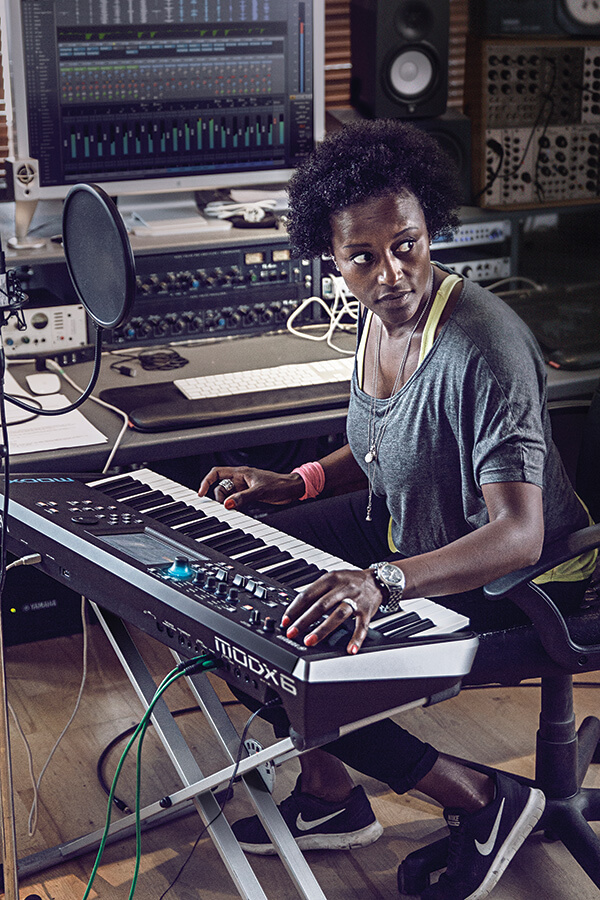
OK, these types of synths are not everyone’s cup of tea. Your modular guys probably think it’s the very opposite of what they want (actually it’s not when you consider the sonic side of things) and analogue synth fans will find plenty of cheaper options.
MODX is, like MONTAGE, aimed at players and gigging musicians on the one hand, but also sound sculptors on the other. You can do so much in terms of sound design, so if your idea of a great synth is actually great synthesis then, honestly, you won’t find many more powerful options.
And if you read my review of MONTAGE and though to yourself: ‘Yeah, I want that but I don’t have a couple of grand’ then, boy, do you need MODX. Just look to the bottom left of this page where I compare the feature sets.
OK you lose outputs and controllers but the vast majority of the features and the interesting stuff that makes MONTAGE so great are still here in MODX. So yes, you do absolutely need MODX in your life.
What’s the difference then?
OK, so MODX has the two synth engines that Montage boasts. Check. The 16 parts of multitimbrality? Check. The (snigger) Super Knob? Check. The 5.76GB sample library? Check. The 130,000 note sequencer? Check. The 128 note polyphony? Check. The 7” TFT Color Wide VGA LCD touch screen? Check. The Motion Sequencer? Check. The 18 filter types. Check. Same effects? Check. The cuddly toy? Probably…
I think you get the picture. MODX seems to be almost as laden with features as MONTAGE. In fact the only thing I could find that is less is the amount of user memory for your own sampling, reduced to 1GB from 1.7GB on MONTAGE.
But before you get too excited, on closer inspection there are (of course!) other refinements. MONTAGE has extra controllers for a start as MODX lacks its touch strip, some controller buttons and aftertouch. It also has a plastic case as opposed to MONTAGE’s alloy one (but that does also make it lighter).
Then there’s the polyphony. While the AWM engine does have 128 notes, the FM has slipped down to 64 for MODX – still plenty for an FM synth in my book. Finally, one of my criticisms of MONTAGE was that it only had four outputs which, for a synth that powerful, could seem lacking. Well MODX only has the standard two, so even less. Considering its capabilities, that’s a bit like squeezing some kind of sonic camel through the eye of a speaker needle.
However, and it’s a BIG ‘however’, I’ve saved the best bit until last and that is the price (like you hadn’t noticed it in the yellow box above). Yes, MODX is just £1242 – close to half the price of MONTAGE. However many outs it lacks, however plastic it may be, that sounds like a price that is going to seriously shake up this sector of the synth market.
Screen views from the MODX touch screen
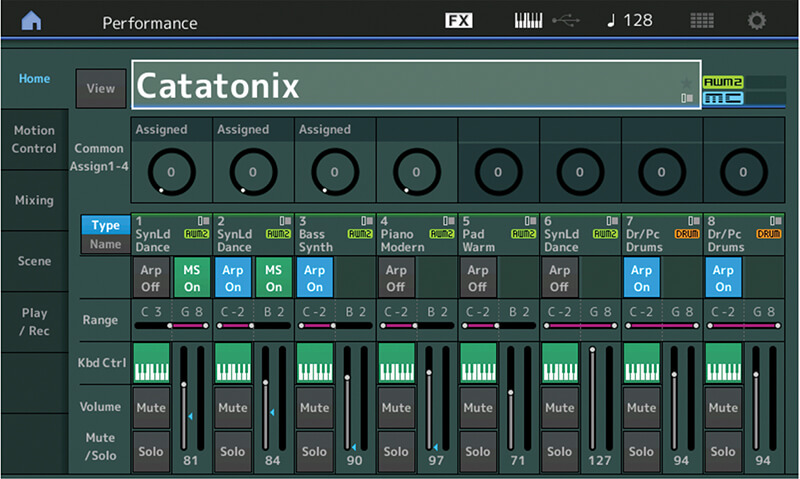
1. Performances
Play big sounds, or multi setups. Here we have 6 parts of AWM2, plus two drum tracks. All levels can be adjusted by the sliders or cursor keys.
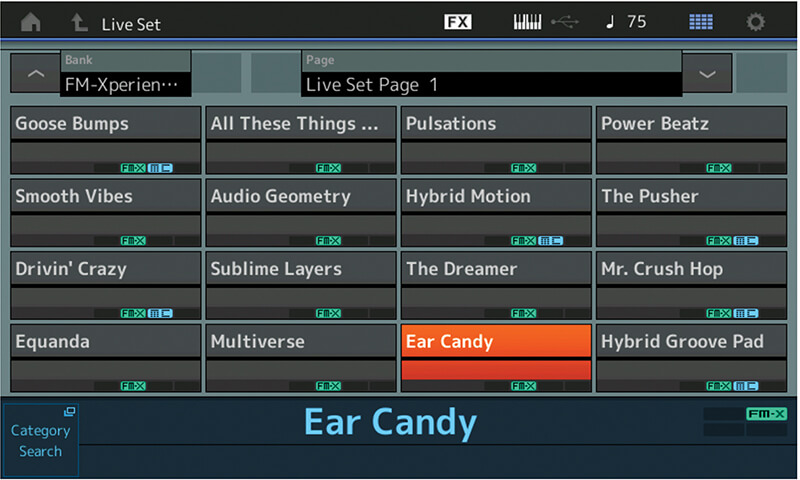
2. Live sets
Playing live you have up to 256 Performances on instant recall and the user memory features up to 8 Live Set banks with 256 Live Set slots each.
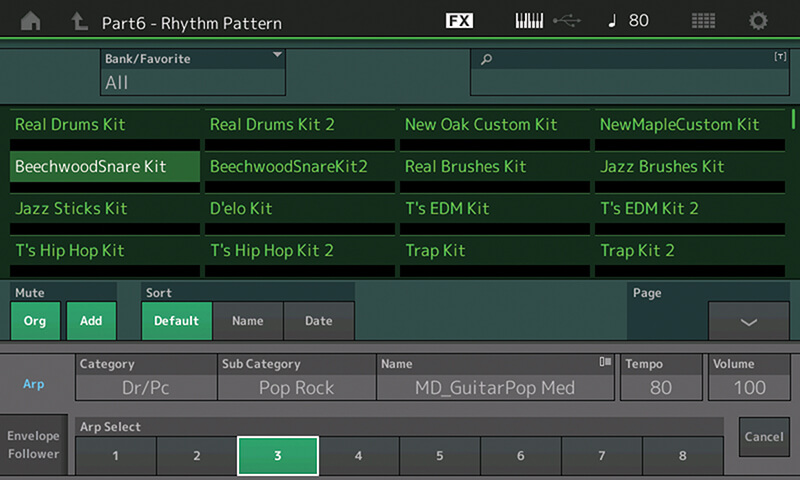
3. Drums
Adding drums or presets to a Performance is dead simple. Here we’re choosing from the many drum kits which also loop as you play.
Mods are rocking
So you know the specs and capabilities. This synth is surely going to live and die on how it all hangs together. First, you’ll need to get your head around one main concept and that is that Motion Control Synthesis.
This is the way that MODX creates and synthesises sound over time, utilising both the AWM and FM-X engines. The Super Knob, all the keyboard controllers, the Motion Sequencer and the Arpeggiator can all get involved in Motion Control Synthesis action (plus even more, but I’m trying to keep things relatively simple).
Motion Control is key to MODX’s evolving sounds, its huge atmospheres and even a lot of the realism on its acoustic sounds so, as it is tied so much to the on-board controls, you might think it a shame that some of these have been lost from MONTAGE.
However, as you can see above, the four real-time rotaries can still be assigned to 16 parameters and the four sliders can also be stepped through in groups of four to access 16 parameters, so there is still a lot going on.
The Super Knob is the highlight of the control side of things. It and the controllers mentioned above can pretty much be assigned to anything but the Super Knob on its own can alter up to 16 different parameters in any direction.
On a deep level you can make assignments via the Edit menu and screen, but it’s far easier using a combination of the Assign and Knob Position buttons. Initially you do think, ‘Why would I want to change so many parameters at once?’ But, given the option, you soon find yourself doing it!
At the heart of all of this control is the Motion Sequencer, where each sequence lane can be a controller source and control up to 16 destinations simultaneously. Here, you can create wildly-evolving sounds which are great for any kind of sound design.
I struggled with this section a little on MONTAGE – not so much the idea, but the execution – but on MODX there is a very useful Motion Control screen that shows you what is assigned to what in terms of controllers, dials and the Super Knob which, at the very least, draws everything together on what is assigned where.
Yamaha MODX: The front panel in detail
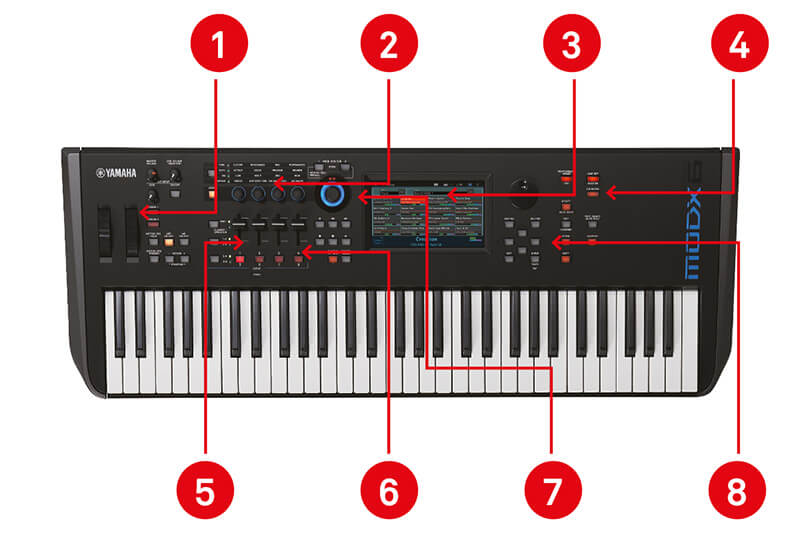
1. Global controls
Alongside the pitch bend and mod wheel you get global controls for volume and, usefully, a separate one for USB volume level. Below these are the AD input level and on-off switch and then assignable switches and Motion Sequence and Arp controls.
2. Assignable rotaries
These can be assigned to some of the most common tone, EQ, effect and envelope parameters of a sound and adjusted analogue style. The MONTAGE has more of these which is one of the big differences between the two synths.
3. Touch screen
That the 7” TFT Color Wide VGA LCD touch screen was retained on MODX is perhaps the biggest surprise in terms of cost, but here it is in all its glory and is probably the heart and soul of the machine’s ease of use, and a standout feature.
4. Performances
Choose between Performances which can be huge sets of sounds played together or individually via MIDI and Live Sets which can be different Performances or song parts recalled by touching a grid of up to 16 shown on the screen.
5. Sliders
Four sliders can be assigned to 16 different locations with separate buttons to step through each group. Typically these can control levels of individual parts in a Performance.
6. Scenes
There are eight Scenes which can recall different set-ups at the touch of a button for various sections, including Motion Sequence, Super Knob, Arpeggio and mix set-ups.
7. Super knob
One of the standout features from MONTAGE finds its way onto MODX and basically allows several parameters to be changed in any direction with one turn of the knob. Great for live performance tricks.
8. More controls
For finer tuning, or if the parts on the screen are too small to touch, you can navigate around it using these cursors, hitting Enter and Exit or Increment/Decrement.
The screen is key
And talking of the screen, it is very much what draws you in the most and another highlight of MODX. You’ll find yourself adapting your ‘screen use style’ as you progress with the keyboard. Generally it’s a case of touching whatever you want to change and then altering it via sliders or rotaries. Or you can step around using cursors and increment/decrement buttons for more detailed operation; up to you.
It makes selecting sounds or Performances an absolute breeze. You can step through them, old-school style, or you can use the comprehensive search by category and sub category which makes homing in on what you want that much easier.
These Performances are essentially multitimbral set-ups where up to 16 instrument sounds from the AWM2 and FM-X engines, or drums sounds from AWM2, can be grouped together. These might be played together as a set of sounds split across a keyboard, for example, or as huge soundscapes where lots of presets are played together utilising that vast polyphony.
Or you could trigger different sounds via different MIDI channels and record via the on-board or external sequencer, much like you’d use a traditional module. Then there are Live Sets where up to 256 slots are available to step through – ideal for live players changing to different Performances for songs in a set.
Screen views from the MODX touch screen (cont.)
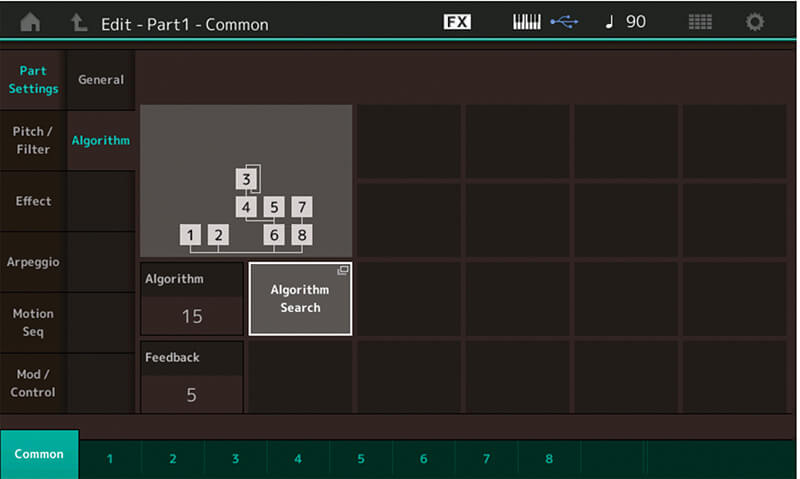
4. FM-X synthesis
MODX does FM relatively easily by allowing you to select algorithms (of 88) from a matrix, and there are no deep, dark and scary menus to access.
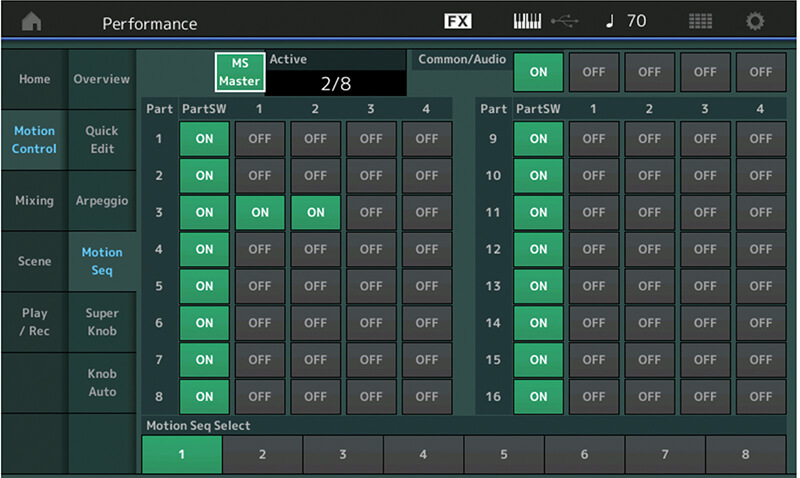
5. Motion sequencer
Record and automate over four lanes on eight sequencer tracks in the Motion Sequencer to really get your sounds moving and evolving.
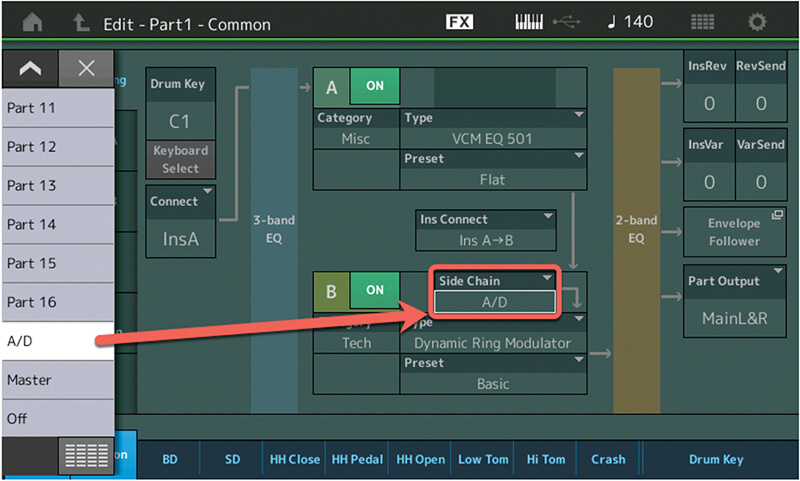
6. Side-chain effect
It’s easy to select a source, like a 4/4 kick drum from a part in a Performance, and modulate one of ten compressors to get ‘that’ ducking effect.
How does it stack up?
So far I’ve focussed on what you can do with MODX’s sound, with the Motion Control umbrella and the synth engines within it combined with all of those controls – and I think you’ll agree that’s a lot. This is the key to the synth and almost puts the sounds at MODX’s core in the shade.
It would be a shame to not touch upon them, though, especially as there are literally thousands of them, covering everything you need and everything you thought you didn’t need.
Basically two words sum them up: ‘huge’ and ‘real’. The acoustic sounds – so often helped by subtle Performance layering, splits, superb effects and clever use of Motion Control – are among the most ‘real’ I have heard.
The more electronic side of the synth is again helped even more with Motion Control as the synths, arpeggios, pads and strings swirl more than ever, and even if some of the leads are a little corporate and obvious – kind of like ‘this is EDM 2008’ it really doesn’t matter.
You’ve got 16 parameters to play with on Super Knob alone, 32 to automate in Motion Sequencer, and you’ve got 192 notes you can layer together. You want sonic control? You want huge sounds? You’ve got it… and then some.
I could then try and give you some more detail on the sounds but you’re talking about one engine that utilises a library eight times the size of the one used on the celebrated MOTIF series and an FM engine which is both accessible and powerful. Overall, you will not be lacking great ingredients, and the kitchen is amazing.
Conclusion
Give me another four pages and I probably still won’t do MODX justice in terms of its depth and capability. It’s slightly more complex to use than I remember MONTAGE being, but that might be down to the lack of controls in some areas making it a little less approachable.
However the Motion Control stuff is very easy to use on a simple level. Assign a parameter here, turn a knob, done. If you want to get into the more complex stuff within the Motion Sequencer, it’s all there waiting for you.
However, the real beauty of MODX is that you don’t have to if you don’t want to – you really can enjoy it on whatever level you want. Explore the many sounds, tweak them here and there, immerse yourself in huge performances, and set up easy set lists for live play.
I have to mention the screen too. An hour after using it, I’d forgotten I was using it, if that makes sense. It partly has the feel of some kind of touch-screen DAW and like MONTAGE, really does offer a kind of hybrid hardware/software experience.
Last but most definitely not least, there’s the price. No matter how niggled you might be by the lack of outs, or concerned by some ease of use issues as you go deeper underground, put simply, this kind of sonic power and hands-on control for the asking price is fantastic.
Alternatives
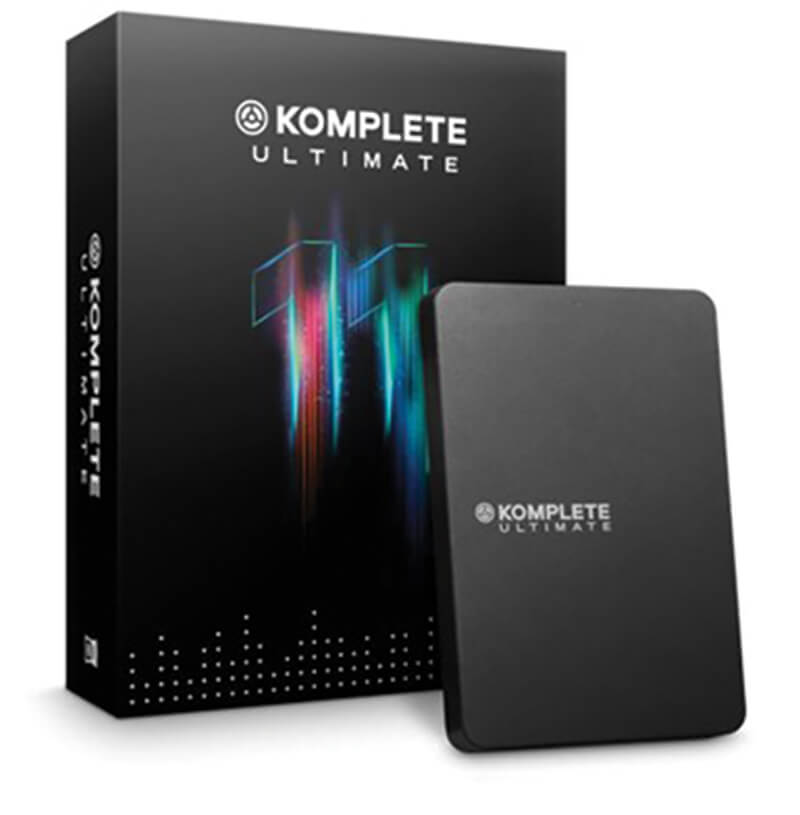
Native Instruments
Komplete Ultimate + Komplete Kontrol £800-£1500
I know, I’m ignoring your Korgs and Rolands but Komplete Kontrol, along with the Ultimate suite of software, explores similar sounds and blurs the hardware/software barrier too.
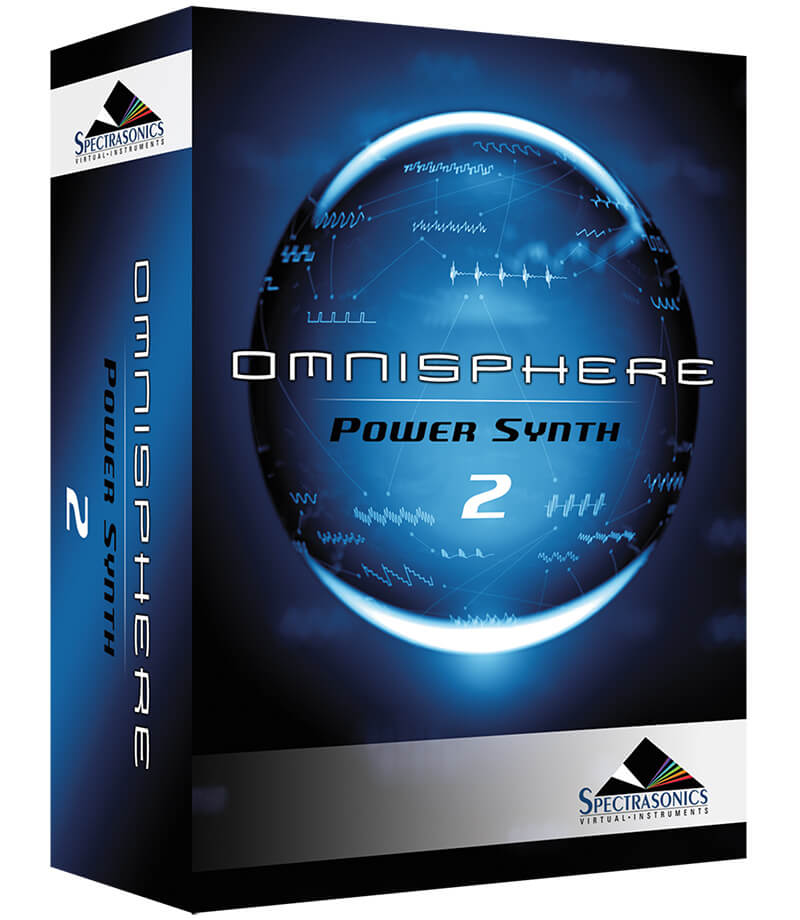
Spectrasonics
Omnisphere From £339
And another software alternative but you have to take into account the kind of synth power that MODX displays, and Omnisphere is just about the most capable of soft synths for exploring similar kinds of sonic territories.